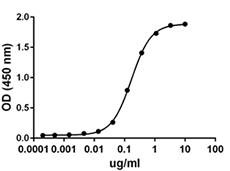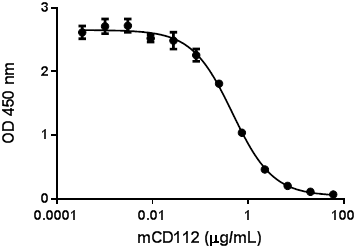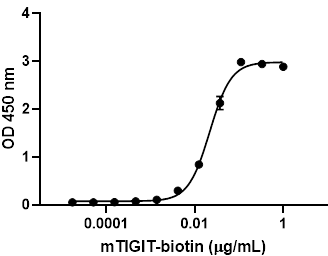- Regulatory Status
- RUO
- Other Names
- B7-2, B lymphocyte activation antigen B7-2, LAB7-2, B70, B72 antigen, Ly-58, CD28 antigen ligand 2, CD28LG2, BU63
- Ave. Rating
- Submit a Review
- Product Citations
- publications

-

Immobilized recombinant mouse CD86 binds mouse CTLA-4 (Cat. No. 591802) in a dose dependent manner with EC50 of 5 - 20 ng/mL. -
Stability testing for Mouse CD86. Mouse CD86 was aliquoted in PBS, pH 7.2 at 0.2 mg/ml. One aliquot was freeze and thawed four times (4x freeze/thaws), and compared to a control kept at 4°C (control). The samples were tested for their ability to bind mouse CTLA-4 (Cat. No. 591802).
CD86, also known as B7-2, is a member of cell surface immunoglobulin superfamily. B7 family members are transmembrane molecules that exist predominantly as monomers. They are classified into three groups according to their functions. Group I members include B7-1, B7-2, and B7-H2. These members are either co-stimulatory or co-inhibitory in modulating T cell response. Group II members include B7-H1 (PD-L1) and B7-DC (PD-L2) which are ligands for PD-1. These members are involved in regulating induction and maintenance of peripheral immune tolerance. Group III members include B7-H3 and B7-H4 whose role in T cell regulation has yet to be defined. CD86 is expressed on activated B and T cells, macrophages, dendritic cells, and astrocytes. CD86, along with CD80, is a ligand of CD28 and CD152 (CTLA-4). CD86 is expressed earlier in the immune response than CD80. CD86 has also been shown to be involved in immunoglobulin class-switching and triggering of NK cell-mediated cytotoxicity. CD86 binds to CD28 to transduce co-stimulatory signals for T cell activation, proliferation, and cytokine production. CD86 can also bind to CD152, also known as CTLA-4, to deliver an inhibitory signal to T cells.
Product DetailsProduct Details
- Source
- Mouse CD86, amino acids Val26-Glu245 (Accession # P42082) with a C-terminal human IgG1 Fc-6His tag was expressed in 293E cells.
- Molecular Mass
- The 486 amino acid recombinant protein has a predicted molecular mass of approximately 54.9 kD. The DTT-reduced protein migrates at approximately 70 kD and and non-reduced protein migrates at approximately 140 kD by SDS-PAGE. The predicted N-terminal amino acid is Val.
- Purity
- > 95%, as determined by Coomassie stained SDS-PAGE.
- Formulation
- 0.22 µm filtered protein solution is in PBS, pH 7.2.
- Endotoxin Level
- Less than 0.1 EU per µg protein as determined by the LAL method.
- Concentration
- 10 and 25 µg sizes are bottled at 200 µg/mL. 100 µg size and larger sizes are lot-specific and bottled at the concentration indicated on the vial. To obtain lot-specific concentration and expiration, please enter the lot number in our Certificate of Analysis online tool.
- Storage & Handling
- Unopened vial can be stored between 2°C and 8°C for up to 2 weeks, at -20°C for up to six months, or at -70°C or colder until the expiration date. For maximum results, quick spin vial prior to opening. The protein can be aliquoted and stored at -20°C or colder. Stock solutions can also be prepared at 50 - 100 µg/mL in appropriate sterile buffer, carrier protein such as 0.2 - 1% BSA or HSA can be added when preparing the stock solution. Aliquots can be stored between 2°C and 8°C for up to one week and stored at -20°C or colder for up to 3 months. Avoid repeated freeze/thaw cycles.
- Activity
- When mouse CD86 is immobilized at 0.5 µg/mL, mCTLA-4 (Cat. No. 591802) binds with EC50 of 5 - 20 ng/mL.
- Application
-
Bioassay
- Application Notes
-
BioLegend carrier-free recombinant proteins provided in liquid format are shipped on blue-ice. Our comparison testing data indicates that when handled and stored as recommended, the liquid format has equal or better stability and shelf-life compared to commercially available lyophilized proteins after reconstitution. Our liquid proteins are verified in-house to maintain activity after shipping on blue ice and are backed by our 100% satisfaction guarantee. If you have any concerns, contact us at tech@biolegend.com.
Antigen Details
- Structure
- Homodimer
- Distribution
-
B cells and T cells (upregulated upon activation), macrophages, dendritic cells, and astrocytes.
- Function
- Receptor involved in the costimulatory signal essential for T-lymphocyte proliferation and interleukin-2 production, by binding CD28 or CTLA-4.
- Interaction
- Leukocytes, endothelial cells
- Ligand/Receptor
- CTLA-4, CD28
- Bioactivity
- Measured by the ability of immobilized protein to bind mouse CTLA-4.
- Biology Area
- Cell Biology, Immunology, Neuroscience, Neuroscience Cell Markers, Costimulatory Molecules
- Molecular Family
- CD Molecules, Immune Checkpoint Receptors, Soluble Receptors
- Antigen References
-
- Freeman GJ, et al. 1993. Science. 262:909.
- Chen C, et al. 1994. J. Immunol. 152:4929.
- Lanier LL, et al. 1995. J. Immunol. 154:97.
- Carreno BM, Collins M. 2002. Annu. Rev. Immunol. 20:29.
- Rudd CE, et al. 2009. Immunol. Rev. 229:12.
- Wing K, et al. 2011. Trends Immunol. 32:428.
- Gene ID
- 12524 View all products for this Gene ID
- UniProt
- View information about CD86 on UniProt.org
Related FAQs
- Why choose BioLegend recombinant proteins?
-
• Each lot of product is quality-tested for bioactivity as indicated on the data sheet.
• Greater than 95% Purity or higher, tested on every lot of product.
• 100% Satisfaction Guarantee for quality performance, stability, and consistency.
• Ready-to-use liquid format saves time and reduces challenges associated with reconstitution.
• Bulk and customization available. Contact us.
• Learn more about our Recombinant Proteins. - How does the activity of your recombinant proteins compare to competitors?
-
We quality control each and every lot of recombinant protein. Not only do we check its bioactivity, but we also compare it against other commercially available recombinant proteins. We make sure each recombinant protein’s activity is at least as good as or better than the competition’s. In order to provide you with the best possible product, we ensure that our testing process is rigorous and thorough. If you’re curious and eager to make the switch to BioLegend recombinants, contact your sales representative today!
- What is the specific activity or ED50 of my recombinant protein?
-
The specific activity range of the protein is indicated on the product datasheets. Because the exact activity values on a per unit basis can largely fluctuate depending on a number of factors, including the nature of the assay, cell density, age of cells/passage number, culture media used, and end user technique, the specific activity is best defined as a range and we guarantee the specific activity of all our lots will be within the range indicated on the datasheet. Please note this only applies to recombinants labeled for use in bioassays. ELISA standard recombinant proteins are not recommended for bioassay usage as they are not tested for these applications.
- Have your recombinants been tested for stability?
-
Our testing shows that the recombinant proteins are able to withstand room temperature for a week without losing activity. In addition the recombinant proteins were also found to withstand four cycles of freeze and thaw without losing activity.
- Does specific activity of a recombinant protein vary between lots?
-
Specific activity will vary for each lot and for the type of experiment that is done to validate it, but all passed lots will have activity within the established ED50 range for the product and we guarantee that our products will have lot-to-lot consistency. Please conduct an experiment-specific validation to find the optimal ED50 for your system.
- How do you convert activity as an ED50 in ng/ml to a specific activity in Units/mg?
-
Use formula Specific activity (Units/mg) = 10^6/ ED50 (ng/mL)

 Login / Register
Login / Register 














Follow Us